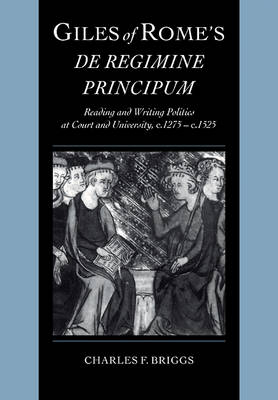
Giles of Rome's De regimine principum
Reading and Writing Politics at Court and University, c.1275–c.1525
Seiten
2008
Cambridge University Press (Verlag)
978-0-521-10344-2 (ISBN)
Cambridge University Press (Verlag)
978-0-521-10344-2 (ISBN)
This study uses an interdisciplinary approach towards the surviving manuscript copies of Giles of Rome's De regimine principum to show how people of the later Middle Ages read the text and appropriated it for both lay and clerical purposes.
From the time of its composition (c.1280) for Philip the Fair of France until the early sixteenth century, Giles of Rome's mirror of princes, the De regimine principum, was read by both lay and clerical readers in the original Latin and in several vernacular translations, and served as model or source for several works of princely advice. This study examines the relationship between this didactic political text and its audience by focusing on the textual and material aspects of the surviving manuscript copies, as well as on the evidence of ownership and use found in them and in documentary and literary sources. Briggs argues that lay readers used De regimine for several purposes, including as an educational treatise and military manual, whereas clerics, who often first came into contact with it at university, glossed, constructed apparatus for, and modified the text to suit their needs in their later professional lives.
From the time of its composition (c.1280) for Philip the Fair of France until the early sixteenth century, Giles of Rome's mirror of princes, the De regimine principum, was read by both lay and clerical readers in the original Latin and in several vernacular translations, and served as model or source for several works of princely advice. This study examines the relationship between this didactic political text and its audience by focusing on the textual and material aspects of the surviving manuscript copies, as well as on the evidence of ownership and use found in them and in documentary and literary sources. Briggs argues that lay readers used De regimine for several purposes, including as an educational treatise and military manual, whereas clerics, who often first came into contact with it at university, glossed, constructed apparatus for, and modified the text to suit their needs in their later professional lives.
1. Giles of Rome and De regimine principum; 2. Books, contents, uses; 3. A book of kings and knighthood; 4. From Latin into English; 5. A university textbook; 6. Improving access and removing the chaff; Conclusion
| Reihe/Serie | Cambridge Studies in Palaeography and Codicology |
|---|---|
| Zusatzinfo | 8 Tables, unspecified; 17 Halftones, unspecified |
| Verlagsort | Cambridge |
| Sprache | englisch |
| Maße | 170 x 244 mm |
| Gewicht | 360 g |
| Themenwelt | Geisteswissenschaften ► Archäologie |
| Geschichte ► Hilfswissenschaften ► Paläografie | |
| Geisteswissenschaften ► Sprach- / Literaturwissenschaft ► Sprachwissenschaft | |
| ISBN-10 | 0-521-10344-4 / 0521103444 |
| ISBN-13 | 978-0-521-10344-2 / 9780521103442 |
| Zustand | Neuware |
| Haben Sie eine Frage zum Produkt? |
Mehr entdecken
aus dem Bereich
aus dem Bereich
Schnelle Hilfe bei häufigen Fehlern
Buch | Softcover (2021)
UTB (Verlag)
CHF 25,20
Eine Geschichte der Welt in neun geheimnisvollen Schriften
Buch | Hardcover (2021)
C.H.Beck (Verlag)
CHF 34,95


